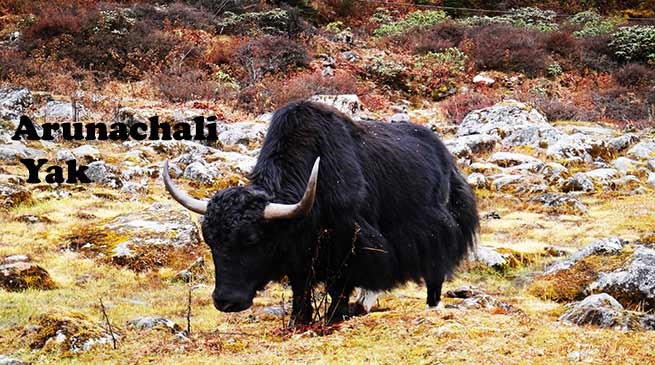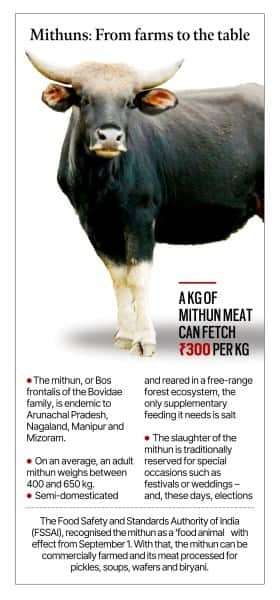Description

Disclaimer: Copyright infringement not intended.
Context
- The recognition of Mithun as a 'food animal' and the efforts to promote its meat as a commercial product can indeed have significant economic and cultural implications for the region.
Details
- Cultural Significance: Mithun holds deep cultural and ritual significance in the northeastern states of India, and it is considered the state animal of Arunachal Pradesh and Nagaland. Its role in traditional practices and ceremonies reflects its importance in the cultural heritage of the region.
- Semi-Domestication: Mithun is traditionally semi-domesticated and thrives in a free-range forest ecosystem, requiring minimal human intervention. This approach aligns with sustainable and eco-friendly agricultural practices.
- Commercial Potential: The recognition of Mithun as a 'food animal' by the FSSAI has opened up opportunities for farmers and tribal communities to benefit economically from the sale and processing of Mithun meat. Its low-fat content makes it a potential premium meat product, catering to health-conscious consumers.
- Diversification of Products: Efforts to market various Mithun products, such as vacuum-packed dry meat, pickles, soups, wafers, and instant biryani, indicate a move toward diversification and value addition, expanding its market beyond the northeastern region.

About Mithun: The Bos Gaurus of Northeast India
- Mithun, scientifically known as Bos frontalis, is a remarkable bovine species native to the lush and hilly regions of Northeast India, particularly the states of Arunachal Pradesh, Nagaland, Manipur, and Mizoram.
- Often referred to as the "Cattle of the Hills," Mithun holds significant cultural, economic, and ecological importance in this region.
Physical Characteristics:
- Mithun resembles the domestic cattle but exhibits distinctive features such as a hump over its shoulders, long upward-curving horns, and a dewlap (skin flap) under its throat.
- Their coat color varies, including shades of black, brown, and white. The coloration is often influenced by their age and region.
Cultural Significance:
- Mithun plays a central role in the cultures and traditions of many indigenous communities in Northeast India. It is often referred to as the "family bank" due to its economic importance.
- In various tribal societies, Mithun is used in rituals, festivals, and ceremonies, signifying prosperity and social status.
Economic Value:
- Mithun is a valuable asset for local communities, serving as a source of livelihood and sustenance.
- They are used for meat, milk, and hides, with their meat considered a delicacy in the region. Mithun's meat is lean, tender, and sought after.
- Mithun farming is an integral part of the traditional agro-pastoral system in these regions.
Conservation Status:
- Mithun is categorized as a Schedule I animal under the Wildlife (Protection) Act of India, providing it with legal protection.
- Habitat loss, hunting, and disease outbreaks are some of the key threats to the Mithun population. Conservation efforts are essential to safeguard their future.
- It is listed in CITES Appendix I.
Ecological Role:
- Mithun contributes to the ecological balance in their habitat by grazing on various plant species and influencing vegetation dynamics.
- They are adapted to hilly terrains and can access resources in areas less accessible to other livestock.
Breeding and Farming:
- Efforts are being made to improve Mithun breeding through controlled mating and genetic selection.
- Mithun farming is being promoted as a sustainable livelihood option for local communities, contributing to their economic development.
Challenges:
- Mithun populations face numerous challenges, including habitat fragmentation due to development projects, competition with domestic cattle, and the risk of diseases like foot-and-mouth disease (FMD).

Conclusion
Mithun is a captivating and culturally significant bovine species found in Northeast India. Its role in the livelihoods of indigenous communities, ecological balance, and local traditions make it a species of immense importance that warrants conservation and sustainable management efforts.
|
PRACTICE QUESTION
Q. Which of the following statements about Mithun (Bos frontalis) is correct?
- Mithun is native to the plains of North India.
- It is primarily raised for its milk production.
- Mithun is culturally significant in Northeast India.
- The coat color of Mithun is uniform, typically brown.
A) 1 and 2
B) 2 and 4
C) 3 only
D) 3 and 4
Correct Answer: C) 3 only
|
https://indianexpress.com/article/india/northeasts-mithun-gets-food-animal-tag-and-its-meat-a-leg-up-8948348/













